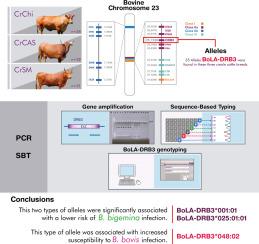哥伦比亚东北部克里奥尔牛中BoLA-DRB3的遗传多样性及其与边缘无原体和巴贝斯虫感染的关系
IF 1.4
Q3 PARASITOLOGY
Veterinary parasitology, regional studies and reports
Pub Date : 2025-10-01
DOI:10.1016/j.vprsr.2025.101355
引用次数: 0
摘要
BoLA-DRB3基因是牛中最具多态性的基因座之一,其等位基因与几种传染病的易感性或抗性相关,包括白血病、乳腺炎和嗜血血性感染。在这项研究中,我们评估了三个哥伦比亚克里奥尔牛品种的BoLA-DRB3基因的遗传多样性,并研究了其与哥伦比亚东北部边缘无形体和巴贝斯虫自然感染的关系。采用pcr -直接测序技术对来自Arauca、Casanare、Meta和Santander省的97只动物(Chino - CrChi, n = 34; Casanareño - CrCAS-, n = 32; Sanmartinero - CrSM-, n = 31)进行BoLA-DRB3基因第二外显子的基因分型。总体遗传多样性中等,核苷酸多样性π = 0.086,平均两两距离18.97,分离位点62个。品种中,CrCAS品种多样性最高,CrChi品种次之,CrSM品种次之。我们鉴定了35个BoLA-DRB3等位基因,其中34个先前在IPD-MHC数据库中报道过,而一个是新发现的。CrChi种群明显偏离Hardy-Weinberg平衡。两个等位基因,BoLA-DRB3 * 001:01和BoLA-DRB3 * 025:01:01,明显与CrSM b . bigemina感染风险降低有关,而BoLA-DRB3 * 048:02与增加易感性在CrChi b宝。这项研究证实了哥伦比亚克里奥尔牛品种的高遗传变异性。CrSM中与双双双歧杆菌感染相关的等位基因的高频率突出了其作为未来研究评估这些等位基因的遗传能力和功能的遗传库的潜力。相比之下,CrChi中牛双歧杆菌感染易感性相关等位基因的频率升高,以及近亲繁殖的证据,强调了迫切需要有针对性的保护和育种策略,以保持遗传多样性并减少该品种对传染病的疾病易感性。本文章由计算机程序翻译,如有差异,请以英文原文为准。

Genetic diversity of BoLA-DRB3 and its association with Anaplasma marginale and Babesia spp. infections in creole cattle of northeastern Colombia
The BoLA-DRB3 gene is one of the most polymorphic loci in cattle, with alleles associated with susceptibility or resistance to several infectious diseases, including leukosis, mastitis, and hemotropic infections. In this study, we assessed the genetic diversity of the BoLA-DRB3 gene in three Colombian Creole cattle breeds and examined its association with natural infections by Anaplasma marginale and Babesia spp. in northeastern Colombia. A total of 97 animals (Chino – CrChi, n = 34; Casanareño - CrCAS-, n = 32; Sanmartinero - CrSM-, n = 31) from Arauca, Casanare, Meta, and Santander departments were genotyped using PCR–direct sequencing of the second exon of the BoLA-DRB3 gene. Overall genetic diversity was moderate, with a nucleotide diversity of π = 0.086, a mean pairwise distance of 18.97, and 62 segregating sites. Among the breeds, CrCAS showed the highest diversity, followed by CrChi and CrSM. We identified 35 BoLA-DRB3 alleles, 34 of which were previously reported in the IPD-MHC database, while one was novel. The CrChi population showed significant deviation from Hardy–Weinberg equilibrium. Two alleles, BoLA-DRB3*001:01 and BoLA-DRB3*025:01:01, were significantly associated with reduced risk of B. bigemina infection in CrSM, whereas BoLA-DRB3*048:02 was linked to increased susceptibility to B. bovis in CrChi. This study confirms the high genetic variability of Colombian Creole cattle breeds. The high frequency of alleles associated with B. bigemina infection in CrSM highlights its potential as a genetic reservoir for future studies evaluating the heritability and functionality of these alleles. In contrast, the elevated frequency of a susceptibility-associated allele for B. bovis infection in CrChi, together with evidence of inbreeding, underscores the urgent need for targeted conservation and breeding strategies to preserve genetic diversity and reduce disease vulnerability to infectious diseases in this breed.
求助全文
通过发布文献求助,成功后即可免费获取论文全文。
去求助
来源期刊
CiteScore
2.90
自引率
7.10%
发文量
126
审稿时长
97 days
期刊介绍:
Veterinary Parasitology: Regional Studies and Reports focuses on aspects of veterinary parasitology that are of regional concern, which is especially important in this era of climate change and the rapid and often unconstrained travel of people and animals. Relative to regions, this journal will accept papers of the highest quality dealing with all aspects of disease prevention, pathology, treatment, epidemiology, and control of parasites within the field of veterinary medicine. Also, case reports will be considered as they add to information related to local disease and its control; such papers must be concise and represent appropriate medical intervention. Papers on veterinary parasitology from wildlife species are acceptable, but only if they relate to the practice of veterinary medicine. Studies on vector-borne bacterial and viral agents are suitable, but only if the paper deals with vector transmission of these organisms to domesticated animals. Studies dealing with parasite control by means of natural products, both in vivo and in vitro, are more suited for one of the many journals that now specialize in papers of this type. However, due to the regional nature of much of this research, submissions may be considered based upon a case being made by the author(s) to the Editor. Circumstances relating to animal experimentation must meet the International Guiding Principles for Biomedical Research Involving Animals as issued by the Council for International Organizations of Medical Sciences (obtainable from: Executive Secretary C.I.O.M.S., c/o W.H.O., Via Appia, CH-1211 Geneva 27, Switzerland).

 求助内容:
求助内容: 应助结果提醒方式:
应助结果提醒方式:


